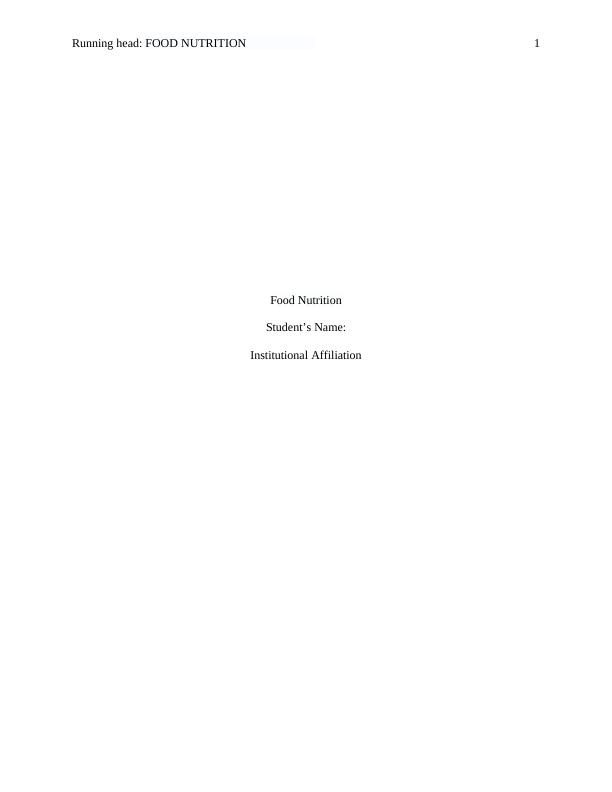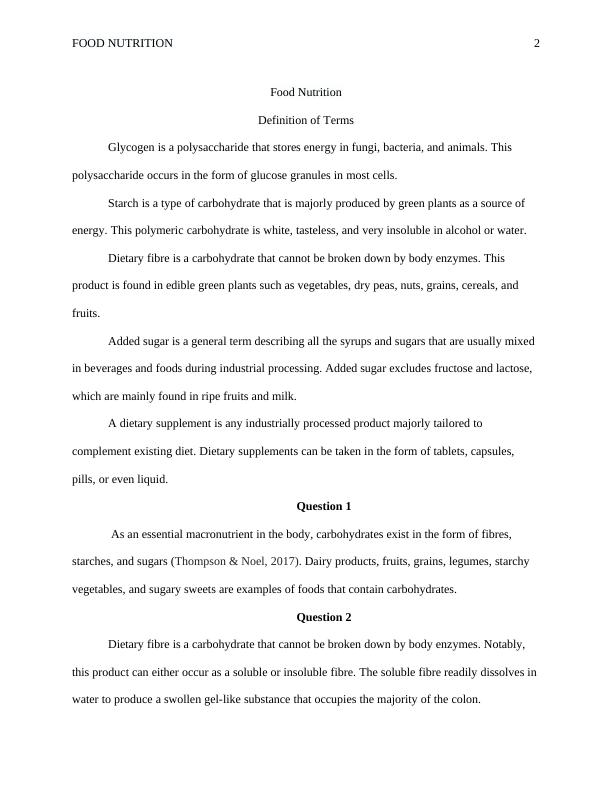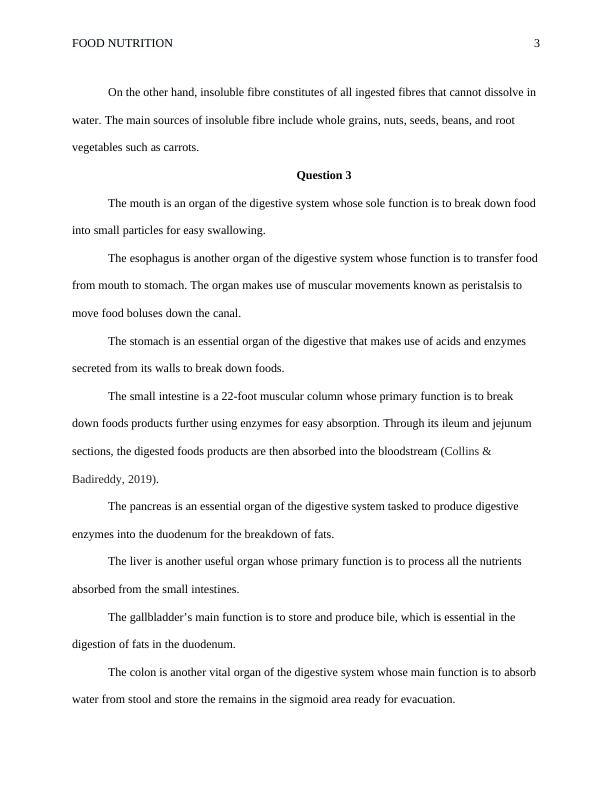Food Nutrition | Definition of Terms
Added on 2022-08-28
6 Pages1138 Words15 Views
Running head: FOOD NUTRITION 1
Food Nutrition
Student’s Name:
Institutional Affiliation
Food Nutrition
Student’s Name:
Institutional Affiliation

FOOD NUTRITION
Food Nutrition
Definition of Terms
Glycogen is a polysaccharide that stores energy in fungi, bacteria, and animals. This
polysaccharide occurs in the form of glucose granules in most cells.
Starch is a type of carbohydrate that is majorly produced by green plants as a source of
energy. This polymeric carbohydrate is white, tasteless, and very insoluble in alcohol or water.
Dietary fibre is a carbohydrate that cannot be broken down by body enzymes. This
product is found in edible green plants such as vegetables, dry peas, nuts, grains, cereals, and
fruits.
Added sugar is a general term describing all the syrups and sugars that are usually mixed
in beverages and foods during industrial processing. Added sugar excludes fructose and lactose,
which are mainly found in ripe fruits and milk.
A dietary supplement is any industrially processed product majorly tailored to
complement existing diet. Dietary supplements can be taken in the form of tablets, capsules,
pills, or even liquid.
Question 1
As an essential macronutrient in the body, carbohydrates exist in the form of fibres,
starches, and sugars (Thompson & Noel, 2017). Dairy products, fruits, grains, legumes, starchy
vegetables, and sugary sweets are examples of foods that contain carbohydrates.
Question 2
Dietary fibre is a carbohydrate that cannot be broken down by body enzymes. Notably,
this product can either occur as a soluble or insoluble fibre. The soluble fibre readily dissolves in
water to produce a swollen gel-like substance that occupies the majority of the colon.
2
Food Nutrition
Definition of Terms
Glycogen is a polysaccharide that stores energy in fungi, bacteria, and animals. This
polysaccharide occurs in the form of glucose granules in most cells.
Starch is a type of carbohydrate that is majorly produced by green plants as a source of
energy. This polymeric carbohydrate is white, tasteless, and very insoluble in alcohol or water.
Dietary fibre is a carbohydrate that cannot be broken down by body enzymes. This
product is found in edible green plants such as vegetables, dry peas, nuts, grains, cereals, and
fruits.
Added sugar is a general term describing all the syrups and sugars that are usually mixed
in beverages and foods during industrial processing. Added sugar excludes fructose and lactose,
which are mainly found in ripe fruits and milk.
A dietary supplement is any industrially processed product majorly tailored to
complement existing diet. Dietary supplements can be taken in the form of tablets, capsules,
pills, or even liquid.
Question 1
As an essential macronutrient in the body, carbohydrates exist in the form of fibres,
starches, and sugars (Thompson & Noel, 2017). Dairy products, fruits, grains, legumes, starchy
vegetables, and sugary sweets are examples of foods that contain carbohydrates.
Question 2
Dietary fibre is a carbohydrate that cannot be broken down by body enzymes. Notably,
this product can either occur as a soluble or insoluble fibre. The soluble fibre readily dissolves in
water to produce a swollen gel-like substance that occupies the majority of the colon.
2

FOOD NUTRITION
On the other hand, insoluble fibre constitutes of all ingested fibres that cannot dissolve in
water. The main sources of insoluble fibre include whole grains, nuts, seeds, beans, and root
vegetables such as carrots.
Question 3
The mouth is an organ of the digestive system whose sole function is to break down food
into small particles for easy swallowing.
The esophagus is another organ of the digestive system whose function is to transfer food
from mouth to stomach. The organ makes use of muscular movements known as peristalsis to
move food boluses down the canal.
The stomach is an essential organ of the digestive that makes use of acids and enzymes
secreted from its walls to break down foods.
The small intestine is a 22-foot muscular column whose primary function is to break
down foods products further using enzymes for easy absorption. Through its ileum and jejunum
sections, the digested foods products are then absorbed into the bloodstream (Collins &
Badireddy, 2019).
The pancreas is an essential organ of the digestive system tasked to produce digestive
enzymes into the duodenum for the breakdown of fats.
The liver is another useful organ whose primary function is to process all the nutrients
absorbed from the small intestines.
The gallbladder’s main function is to store and produce bile, which is essential in the
digestion of fats in the duodenum.
The colon is another vital organ of the digestive system whose main function is to absorb
water from stool and store the remains in the sigmoid area ready for evacuation.
3
On the other hand, insoluble fibre constitutes of all ingested fibres that cannot dissolve in
water. The main sources of insoluble fibre include whole grains, nuts, seeds, beans, and root
vegetables such as carrots.
Question 3
The mouth is an organ of the digestive system whose sole function is to break down food
into small particles for easy swallowing.
The esophagus is another organ of the digestive system whose function is to transfer food
from mouth to stomach. The organ makes use of muscular movements known as peristalsis to
move food boluses down the canal.
The stomach is an essential organ of the digestive that makes use of acids and enzymes
secreted from its walls to break down foods.
The small intestine is a 22-foot muscular column whose primary function is to break
down foods products further using enzymes for easy absorption. Through its ileum and jejunum
sections, the digested foods products are then absorbed into the bloodstream (Collins &
Badireddy, 2019).
The pancreas is an essential organ of the digestive system tasked to produce digestive
enzymes into the duodenum for the breakdown of fats.
The liver is another useful organ whose primary function is to process all the nutrients
absorbed from the small intestines.
The gallbladder’s main function is to store and produce bile, which is essential in the
digestion of fats in the duodenum.
The colon is another vital organ of the digestive system whose main function is to absorb
water from stool and store the remains in the sigmoid area ready for evacuation.
3

End of preview
Want to access all the pages? Upload your documents or become a member.
Related Documents
Structures and Functions of the Digestive System: A Comprehensive Overviewlg...
|10
|841
|93
Nutrition Literacy: Carbohydrateslg...
|10
|2524
|331
Prepare Foods to meet Special Dietary Requirementslg...
|16
|704
|18
Nutrition and Digestion - Digestive Systemlg...
|10
|2100
|10
Nutrition and Digestionlg...
|8
|957
|488
Macronutrients & Micronutrients solutionslg...
|13
|3008
|404
